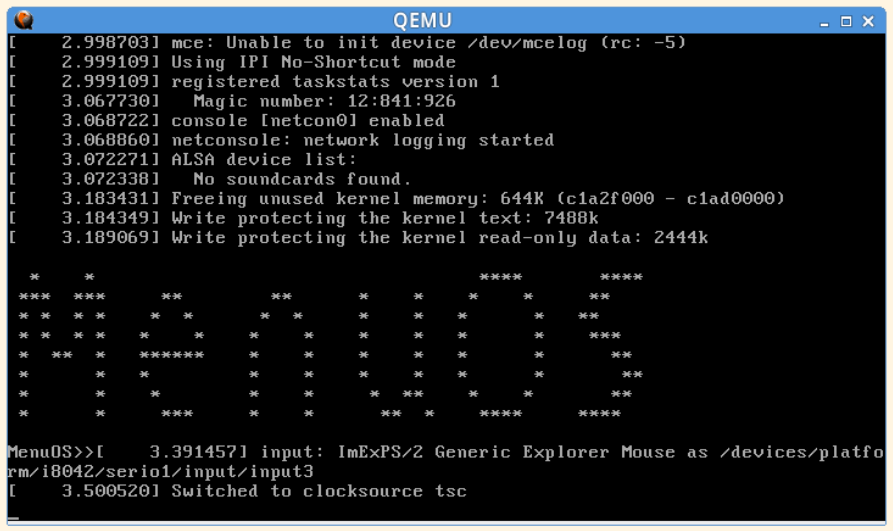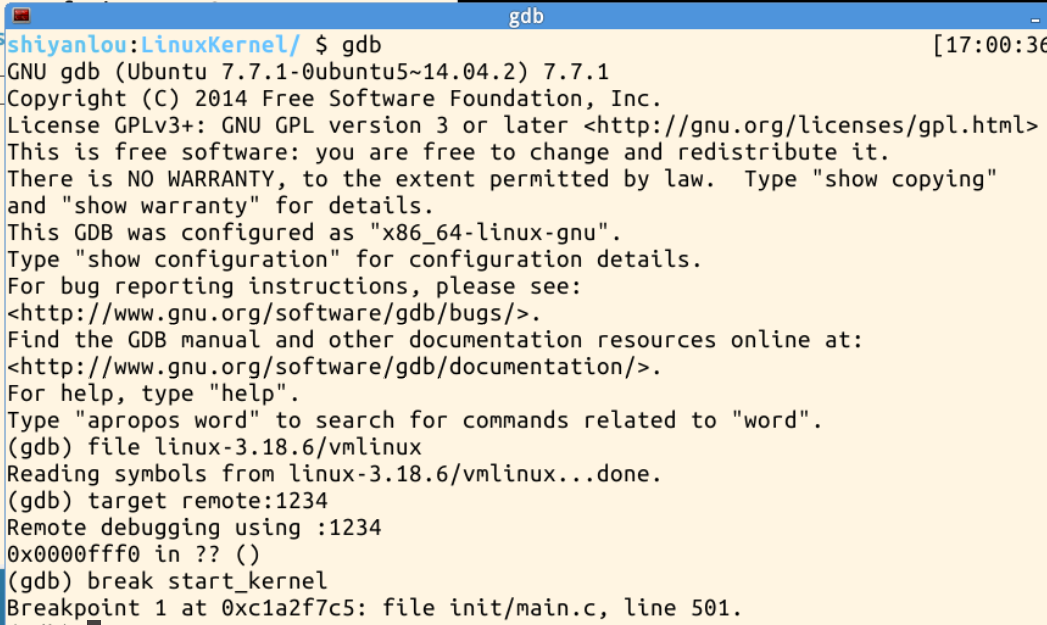2020-2021-1 20209311《Linux内核原理与分析》第四周作业
2020-2021-1 20209311《Linux内核原理与分析》第四周作业
一、实验三 跟踪分析Linux内核的启动过程
1.实验过程
使用实验楼的虚拟机打开shell,内核启动后进入menu程序:
cd ~/LinuxKernel/
qemu -kernel linux-3.18.6/arch/x86/boot/bzImage -initrd rootfs.img

要使用gdb跟踪调试内核,需要在打开menu时添加两个选项s、S:
qemu -kernel linux-3.18.6/arch/x86/boot/bzImage -initrd rootfs.img -s -S
# 关于-s和-S选项的说明:
# 1. -S
# -S freeze CPU at startup (use ’c’ to start execution)
# 2. -s
# -s shorthand for -gdb tcp::1234
# 若不想使用1234端口,则可以使用-gdb tcp:xxxx来取代-s选项

可以看到,-S选项阻止了cpu执行后续指令,-s的作用是打开1234端口号,供后续gdb调试使用。
打开gdb,进入目录后输入以下命令:
file linux-3.18.6/vmlinux
# 在gdb界面中targe remote之前加载符号表
target remote:1234
# 建立gdb和gdbserver之间的连接,按c 让qemu上的Linux继续运行
break start_kernel
# 断点的设置可以在target remote之前,也可以在之后
效果如图所示:

通过设置断点的方法,我们可以跟踪内核的启动过程。
2.实验分析
整个内核中,最关键的函数便是start_kernel函数,这个函数颇为复杂。start_kernel函数的代码如下:
asmlinkage __visible void __init start_kernel(void)
{
char *command_line;
char *after_dashes;
/*
* Need to run as early as possible, to initialize the
* lockdep hash:
*/
lockdep_init();
set_task_stack_end_magic(&init_task);
smp_setup_processor_id();
debug_objects_early_init();
/*
* Set up the the initial canary ASAP:
*/
boot_init_stack_canary();
cgroup_init_early();
local_irq_disable();
early_boot_irqs_disabled = true;
/*
* Interrupts are still disabled. Do necessary setups, then
* enable them
*/
boot_cpu_init();
page_address_init();
pr_notice("%s", linux_banner);
setup_arch(&command_line);
mm_init_cpumask(&init_mm);
setup_command_line(command_line);
setup_nr_cpu_ids();
setup_per_cpu_areas();
smp_prepare_boot_cpu(); /* arch-specific boot-cpu hooks */
build_all_zonelists(NULL, NULL);
page_alloc_init();
pr_notice("Kernel command line: %s\n", boot_command_line);
parse_early_param();
after_dashes = parse_args("Booting kernel",
static_command_line, __start___param,
__stop___param - __start___param,
-1, -1, &unknown_bootoption);
if (!IS_ERR_OR_NULL(after_dashes))
parse_args("Setting init args", after_dashes, NULL, 0, -1, -1,
set_init_arg);
jump_label_init();
/*
* These use large bootmem allocations and must precede
* kmem_cache_init()
*/
setup_log_buf(0);
pidhash_init();
vfs_caches_init_early();
sort_main_extable();
trap_init();
mm_init();
/*
* Set up the scheduler prior starting any interrupts (such as the
* timer interrupt). Full topology setup happens at smp_init()
* time - but meanwhile we still have a functioning scheduler.
*/
sched_init();
/*
* Disable preemption - early bootup scheduling is extremely
* fragile until we cpu_idle() for the first time.
*/
preempt_disable();
if (WARN(!irqs_disabled(),
"Interrupts were enabled *very* early, fixing it\n"))
local_irq_disable();
idr_init_cache();
rcu_init();
context_tracking_init();
radix_tree_init();
/* init some links before init_ISA_irqs() */
early_irq_init();
init_IRQ();
tick_init();
rcu_init_nohz();
init_timers();
hrtimers_init();
softirq_init();
timekeeping_init();
time_init();
sched_clock_postinit();
perf_event_init();
profile_init();
call_function_init();
WARN(!irqs_disabled(), "Interrupts were enabled early\n");
early_boot_irqs_disabled = false;
local_irq_enable();
kmem_cache_init_late();
/*
* HACK ALERT! This is early. We're enabling the console before
* we've done PCI setups etc, and console_init() must be aware of
* this. But we do want output early, in case something goes wrong.
*/
console_init();
if (panic_later)
panic("Too many boot %s vars at `%s'", panic_later,
panic_param);
lockdep_info();
/*
* Need to run this when irqs are enabled, because it wants
* to self-test [hard/soft]-irqs on/off lock inversion bugs
* too:
*/
locking_selftest();
#ifdef CONFIG_BLK_DEV_INITRD
if (initrd_start && !initrd_below_start_ok &&
page_to_pfn(virt_to_page((void *)initrd_start)) < min_low_pfn) {
pr_crit("initrd overwritten (0x%08lx < 0x%08lx) - disabling it.\n",
page_to_pfn(virt_to_page((void *)initrd_start)),
min_low_pfn);
initrd_start = 0;
}
#endif
page_cgroup_init();
debug_objects_mem_init();
kmemleak_init();
setup_per_cpu_pageset();
numa_policy_init();
if (late_time_init)
late_time_init();
sched_clock_init();
calibrate_delay();
pidmap_init();
anon_vma_init();
acpi_early_init();
#ifdef CONFIG_X86
if (efi_enabled(EFI_RUNTIME_SERVICES))
efi_enter_virtual_mode();
#endif
#ifdef CONFIG_X86_ESPFIX64
/* Should be run before the first non-init thread is created */
init_espfix_bsp();
#endif
thread_info_cache_init();
cred_init();
fork_init(totalram_pages);
proc_caches_init();
buffer_init();
key_init();
security_init();
dbg_late_init();
vfs_caches_init(totalram_pages);
signals_init();
/* rootfs populating might need page-writeback */
page_writeback_init();
proc_root_init();
cgroup_init();
cpuset_init();
taskstats_init_early();
delayacct_init();
check_bugs();
sfi_init_late();
if (efi_enabled(EFI_RUNTIME_SERVICES)) {
efi_late_init();
efi_free_boot_services();
}
ftrace_init();
/* Do the rest non-__init'ed, we're now alive */
rest_init();
}
可以看到,start_kernel函数调用了一系列的初始化函数来完成内核本身的设置,包括trap_init函数初始化中断向量,mm_init函数初始化内存管理,sched_init函数初始化调度模块等,最后调用rest_init函数对剩余部分初始化。rest_init函数内容如下:
noinline void __ref rest_init(void)
{
struct task_struct *tsk;
int pid;
rcu_scheduler_starting();
/*
* We need to spawn init first so that it obtains pid 1, however
* the init task will end up wanting to create kthreads, which, if
* we schedule it before we create kthreadd, will OOPS.
*/
pid = kernel_thread(kernel_init, NULL, CLONE_FS);
/*
* Pin init on the boot CPU. Task migration is not properly working
* until sched_init_smp() has been run. It will set the allowed
* CPUs for init to the non isolated CPUs.
*/
rcu_read_lock();
tsk = find_task_by_pid_ns(pid, &init_pid_ns);
set_cpus_allowed_ptr(tsk, cpumask_of(smp_processor_id()));
rcu_read_unlock();
numa_default_policy();
pid = kernel_thread(kthreadd, NULL, CLONE_FS | CLONE_FILES);
rcu_read_lock();
kthreadd_task = find_task_by_pid_ns(pid, &init_pid_ns);
rcu_read_unlock();
/*
* Enable might_sleep() and smp_processor_id() checks.
* They cannot be enabled earlier because with CONFIG_PREEMPT=y
* kernel_thread() would trigger might_sleep() splats. With
* CONFIG_PREEMPT_VOLUNTARY=y the init task might have scheduled
* already, but it's stuck on the kthreadd_done completion.
*/
system_state = SYSTEM_SCHEDULING;
complete(&kthreadd_done);
}
可以看到,rest_init函数创建了init内核线程和kthreadd内核线程,这两个线程会创建1、2号进程。
3.实验收获
0号进程是linux启动的第一个进程,运行在内核态,由系统自动创建。当系统完成初始化后,变为idle进程。
内核在调用start_kernel后,会创建两个内核线程———init和kthreadd。其中,init内核线程最终执行/sbin/init进程,变为所有用户态程序的根进程,即用户空间的init进程,称为1号进程;kthreadd内核线程变为所有内核态其他守护线程的父线程,称为2号进程。
二、Linux知识学习
1.“三大法宝”和“两把宝剑”
计算机的“三大法宝”指:
- 存储程序计算机
- 函数调用堆栈机制
- 中断
操作系统的“两把宝剑”:
- 中断上下文
- 进程上下文
操作系统的两把宝剑:一把是中断上下文的切换——保存现场和恢复现场;另一把是进程上下文的切换。不管是“三大法宝”还是“两把宝剑”,它们都和汇编语言有着密不可分的联系。
2.Linux内核源码的目录结构

- arch:存放了CPU体系结构的相关代码,使Linux内核支持不同的CPU和体系结构。
- block:存放Linux存储体系中关于块设备管理的代码。
- crypto:存放常见的加密算法的C语言代码。
- Documentation:存放一些文档。
- drivers:驱动目录,存放了Linux内核支持的所有硬件设备的驱动源代码。
- firmware:固件。
- fs:文件系统,列出了Linux支持的各种文件系统的实现。
- include:头文件目录,存放公共的头文件。
- init:存放Linux内核启动时的初始化代码。

